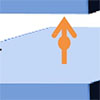| Mar 21, 2022 |
|
(Nanowerk News) In a new publication from Opto-Electronic Advances (“Silicon cuboid nanoantenna with simultaneous large Purcell factor for electric dipole, magnetic dipole and electric quadrupole emission”), researchers from South China University of Technology, Guangzhou, China, discuss silicon cuboid nanoantenna with simultaneous large Purcell factor for electric dipole, magnetic dipole and electric quadrupole emission.
|
 |
| Figure 1. Schematic of the silicon cuboid dielectric optical nanoantenna.
|
|
The Purcell effect is commonly used to increase the spontaneous emission rate by modifying the local environment of a light emitter. The photon state density near the light emitter can be adjusted through the metal or dielectric nanoantennas, thereby modifying its spontaneous emissivity.
|
|
Plasmonic nanoantennas exhibit extraordinary surface plasmon resonances that create a highly localized electric field and increase the local photonic density of states, resulting in the enhancement of spontaneous emission rate. However, the effect is accompanied by unwanted large losses due to strong metal absorption.
|
|
In contrast, dielectric nanoantennas with high permittivity and supporting strong Mie resonances provide the potential to realize low loss manipulation of light scattering. |
|
Recent works have shown that dielectric nanospheres of sufficiently large size can exhibit the electric dipole (ED), magnetic dipole (MD) and electric quadrupole (EQ) resonance modes upon the plane wave illumination and they have been used to enhance the MD emission, or to enhance the ED and MD emission with different nanospheres sizes respectively.
|
|
However, it remains unclear whether these dielectric nanospheres or other more general dielectric nanostructures can be utilized to simultaneously enhance the spontaneous emission from ED, MD and EQ with very low loss and with large magnitude compared to the plasmonic nanostructures.
|
 |
| Figure 2. The Purcell factors as a function of wavelength for electric dipole, magnetic dipole, and electric quadrupole.
|
|
The authors of this article propose a silicon dielectric nanoantenna for simultaneously enhancing electric dipole, magnetic dipole and electric quadrupole emission.
|
|
They study the scattering cross-section, polarized charge distribution and electromagnetic field distribution for electromagnetic plane wave illuminating the silicon dielectric cuboid nanoantenna, thereby identifying simultaneous existence of ED, MD and EQ resonance modes in this nanoantenna.
|
|
The calculated maximum Purcell factor of the ED, MD and EQ emitters at different orientations within the nanoantenna is 18, 150 and 118 respectively, occurring at the resonance wavelength of 475, 750, and 562 nm, respectively, matching with the resonance modes in the nanoantenna and corresponding to the blue, red and green colors.
|
|
The polarization charge distribution features help to clarify the excitation and radiation of these resonance modes as the physical origin of large Purcell factor simultaneously occurring in this silicon cuboid nanoantenna.
|
|
These theoretical results might help to deeply explore and design the dielectric nanoantenna as an ideal candidate to enhance ED, MD and EQ emission simultaneously with a very small loss in the visible range, which is superior to the more popular scheme of the plasmonic nanoantenna.
|



